

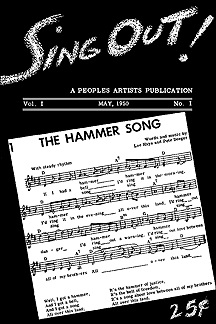
“If I Had a Song ...”
A Thumbnail History of Sing Out!
1950-2000 ... Sharing Songs for 50 Years!
by Roger Deitz
(written for our 45th Anniversary Celebration in 1995,
and revised for the 50th in 2000)
“One little issue of Sing Out! is worth more to humanity than any thousand
tons of dreamy dopey junk dished out from the trees of our forests along
every Broadway in this world. I don’t know of any magazine, big or little,
that comes within a thousand million miles of Sing Out! when it comes to doing
good around the world.” — Woody Guthrie, NYC, 1951
W oody Guthrie knew the value of a fledgling journal with big ambitions. For Woody, his colleagues and a growing chorus of enthusiasts, Sing Out! was more than ink and paper. They believed that by sharing meaningful songs, those of us who cared about making the devil dance to our tune could better stay in touch with the music that would help us do so. The magazine was then, as it is today, a sincere, strong voice raised, not to exploit the profit potential of Tin Pan Alley doggerel, but to promote the best hopes of common people in song.
For so many readers over the last 50 years, folk music began with Sing Out! presenting the best of the new and old. Readers learned songs and found they were very much like the diverse peoples around the world. They greeted neighbors throughout the cities, towns, and rural communities wherever there was a song to sing and a front porch on which to do so.
The fact is, today, Sing Out! The Folk Song Magazine is just one important component of an organization that also publishes song collections, sound recordings, folk music books and directories. Although most readers are familiar with the wealth of folk-related material available in the quarterly magazine and in other Sing Out! publications, they should also know that Sing Out! maintains a sizable multimedia resource center with a significant library of important books, periodicals, sound recordings, oral histories and photographs which may be accessed by the general public, students, scholars and performers. While it’s clear that Sing Out!’s mission has grown since its founding, it has remained true to the spirit and goals of its founders by supporting and preserving traditional and contemporary folk music from all cultures while encouraging practice and participation. Today, Sing Out! boasts readership of nearly 20,000 individuals and organizations worldwide, conducting business with a regular paid staff of six joined by a host of regular contractors and freelancers. Things were not always so.
Sing Out! magazine, now 50 years young, grew out of a legacy of social commitment and a tradition of singing both to effect change and to share the pure enjoyment of songs. The original idea for a magazine was served up by the aspirations of a group of urban singers who believed in the power of song – musicians who raised their voices in harmony and against injustice.
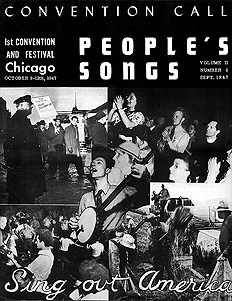 After World War II, a number of artists and enthusiasts including Pete Seeger, Woody Guthrie, Lee Hays, Paul Robeson, Alan Lomax, Irwin Silber and Earl Robinson sought to combine political activism and music as they had before the war. They banded together as People’s Songs, Inc. and began publishing a monthly bulletin to “create, promote, and distribute songs of labor and the American people.”
After World War II, a number of artists and enthusiasts including Pete Seeger, Woody Guthrie, Lee Hays, Paul Robeson, Alan Lomax, Irwin Silber and Earl Robinson sought to combine political activism and music as they had before the war. They banded together as People’s Songs, Inc. and began publishing a monthly bulletin to “create, promote, and distribute songs of labor and the American people.”
People’s Songs, the newsletter, was a novel idea. The bulletin printed songs that would not, as a rule, be available via popular music outlets. The fare would include union songs, peace songs, traditional ballads, children’s songs, blues, gospel, songs of civil rights and international material. Pete Seeger remembers those seminal days which began in the basement of his apartment on MacDougal Street in Greenwich Village in New York City ...
“A number of us who loved to sing folk songs and union songs thought it the most natural thing in the world to start an organization which could keep us in touch with one another, which could promote new and old songs and singers. We called our organization People’s Songs to distinguish it from the scholarly folklore societies and started a bulletin.”
What started as a mimeographed bulletin in short time grew to become a printed magazine. People’s Songs began handling bookings, too, as People’s Artists. Now folk performers would be treated as professionals when they played concerts and hootenannies. New singers and new songs were encouraged, but the bulletin never failed to feature traditional songs, many of which were gathered in the archives of the office. Songs were collected from around the country and around the world. Most were songs about people from all walks of life – they were folk songs People’s Songs also featured reviews and articles including a sharp, entertaining column by Weaver Lee Hays.
Although People’s Songs at one point reached a respectable circulation of 3,000, a dwindling subscriber base and a lack of funds meant closing the office after a three-year run. A combination of finances and politics can be blamed for the demise of People’s Songs. The Cold War was on, and the political climate was changing, with anti-communism and anti-everyonewho-is-differentism on the rise.
On the plus side, this fueled the advent of an active folk song and topical song movement. But on the negative side, the bulletin grew ever more estranged from the labor unions for which People’s Songs originally dedicated its efforts. Redbaiting swept though the labor unions, which sought to distance themselves from folk musicians and the like for fear of appearing “disloyal.”
Increasingly, the publication and its participants were on the defensive against the fierce witch hunting that lumped all liberals, leftists, socialists and communists together as the enemy. The magazine finally went bankrupt shortly after the 1948 presidential election during which People’s Songs and its resources had been pressed into service for the candidacy of Henry Wallace and the Progressive Party.
Although hardly a comfortable political climate for a renewed attempt at publishing a left-wing music magazine, the notion of People’s Songs persisted. A few months later, following a keen reassessment of People’s Songs’ strengths, some of the same group who brought out People’s Songs went back to the drawing board, and returned in May of 1950 with the first issue of Sing Out!
Irwin Silber, in “Notes from an Editor’s Diary,” recalls he borrowed the name Sing Out! from the third verse of the “The Hammer Song” written by Lee Hays and Pete Seeger, which incidentally was printed on the cover of issue number one. It seemed to the publishers an appropriate aim to “sing out danger ... sing out a warning ... sing out love between all my brothers (and my sisters) all over this land.” Over the years, Sing Out! has proved as apt a name as could have applied to the impudent publication that squarely aimed its songs at oppression, and encouraged an army of singers to do the same.
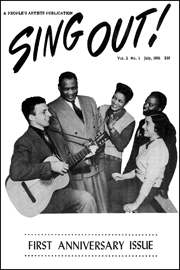 Alongside the advent of Sing Out!, the folk song movement was taking hold. For the most part, it seemed that young people were the ones who were hungry to assimilate old and new folk songs. Now, they could spend a quarter and pick up an issue of Sing Out! to find all manner of songs by the likes of Malvina Reynolds, Pete Seeger and Woody Guthrie.
Alongside the advent of Sing Out!, the folk song movement was taking hold. For the most part, it seemed that young people were the ones who were hungry to assimilate old and new folk songs. Now, they could spend a quarter and pick up an issue of Sing Out! to find all manner of songs by the likes of Malvina Reynolds, Pete Seeger and Woody Guthrie.
With a war on in Korea called a “police action,” anti-communist hysteria deepened, resulting in so much repression around and about. In spite of that, this new publication managed to establish itself. Whenever Pete Seeger, Woody Guthrie or Cisco Houston came to town, they’d sing for the cause and pick up a few dollars for the Sing Out! coffers. Hootenannies continued to help pay the printer who, it is remembered by Silber and the others, was most patient when the bills were due.
During the first decade of publication, Sing Out! printed many important songs that otherwise might have had a hard time catching on. Ed McCurdy’s “Strangest Dream” was one of the more notable songs found in the early years, along with Lead Belly’s “Rock Island Line.” Other songs, never before published such as “Sixteen Tons” and “Pretty Boy Floyd” got their first inking in Sing Out! Most notably, Woody Guthrie’s “This Land Is Your Land” first appeared in print in the pages of Sing Out! during the 1953-1954 volume, the same year Pete Seeger started writing his “Johnny Appleseed, Jr.” column.
Other songs would follow: “Roll On Columbia,” “Putting on the Style,” “Michael Row The Boat Ashore,” “House Of The Rising Sun,” “All My Trials,” “Bells Of Rhymney,” “Cotton Fields At Home” and “The MTA Song.” This is a brief sampling of songs that Sing Out! helped bring to the public. The floodgates were opened for decades of new and old songs to follow.
Meanwhile, there was a curious stirring of commercialism in folk music as major labels and book publishers began to exploit the genre. As the music became more accessible, it reached more listeners. Yet, they weren’t just buying the music, they were taking the music to heart, and these people were becoming Sing Out! readers. Oddly enough, the “revival” of interest in folk music, which was gaining momentum throughout the early years of publication, was not coming from the working class, but from predominantly college-educated young men and women whose collective energy would soon be aimed for social change and humanitarian causes.
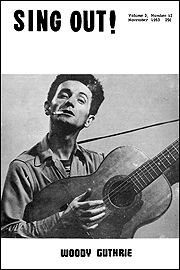 Sing Out! began as a “beautifully amateurish” 16-page pamphlet, but it was a primer for this nonconformity. What was different about this upstart rag was right there in print, set down by its editors in the magazine’s credo: “This magazine is about music. Yes, we realize there are music magazines already in existence. What’s special about this one? Well, there’s music and there’s music. A strange thing has happened to music in our time – it has nothing to do with the people anymore.
Sing Out! began as a “beautifully amateurish” 16-page pamphlet, but it was a primer for this nonconformity. What was different about this upstart rag was right there in print, set down by its editors in the magazine’s credo: “This magazine is about music. Yes, we realize there are music magazines already in existence. What’s special about this one? Well, there’s music and there’s music. A strange thing has happened to music in our time – it has nothing to do with the people anymore.
“We propose to devote ourselves to the creation, growth and distribution of something new, yet not so new, since its beginnings have been visible, or rather audible, for some years now. We call it ‘People’s Music.’ What is this ‘People’s Music’? In the first place, like all folk music, it has to do with the hopes and fears and lives of common people – of the great majority. In the second place, like that other music ... call it ‘composed,’ ‘concert music,’ or whatever – it will grow on the base of folk music.
“We propose that these two divergent lines of music now join in common service to the common people and that is what we call ‘People’s Music.’ No form – folk song, concert song, dance, symphony, jazz is alien to it. By one thing above all else will we judge it: How well does it serve the common cause of humanity?”
By the close of the magazine’s eighth year, it moved uptown to begin a long and close association with Moses Asch and Folkways Records. Oak Publications was formed to create, along with Sing Out! and Folkways, a most formidable alliance for distributing a host of folk-related music and instructional publications. At that same time, the folk boom was being heard ’round the world. The genre as such, would never again be the same. In 1958, The Kingston Trio took “Tom Dooley” to Number One on the pop charts. It was shades of the Weavers “Goodnight Irene” all over again, and then some. Not only did the song reach Number One, but for two years to follow, the group’s recordings accounted for one-fifth the total sales of Capitol Records. Boom!
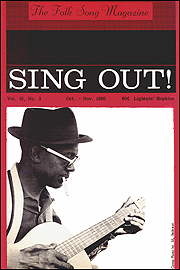 Now, and into the ’60s, The Kingston Trio and other folk groups were regularly on the pop charts. Young urban singers such as The New Lost City Ramblers had songs featured in Sing Out! Events such as the first Newport Folk Festival, featured in a Sing Out! photo essay by Dave Gahr, drew more and more young singers, players and listeners to acoustic music. Boom again!
Now, and into the ’60s, The Kingston Trio and other folk groups were regularly on the pop charts. Young urban singers such as The New Lost City Ramblers had songs featured in Sing Out! Events such as the first Newport Folk Festival, featured in a Sing Out! photo essay by Dave Gahr, drew more and more young singers, players and listeners to acoustic music. Boom again!
The result of the popularization of folk was to send the major record labels scrambling to cash in on this commercial opportunity. As the ’60s began, a stampede was on to sign folk artists and discover “new talent.” A&R reps laid in wait in the scores of small clubs that dotted Greenwich Village. Most of the young folk singers they signed learned songs from Sing Out!, or were having their own songs published therein. Columbia, Vanguard, Decca and Elektra are just a few of the labels to jump on the band – and solo artist – wagon. Corporate America was devouring folk music as we knew it, and regurgitating it in its own image, and Sing Out! got a boost from the movement.
With this growing popularity, new subscriptions poured in. Silber noted in his diary that circulation doubled in 1960, grew to 20,000 by 1964, then again rose to 25,000 by 1965! Ads were being run for Goya and Guild guitars, and for Vanguard, Folkways and Elektra records. Still, Sing Out! remained a leader in supplying meaningful, important songs.
Freedom and civil rights songs were the most visible additions to the repertoire of this period. Oh yes, and someone else was a visible addition. Izzy Young of New York’s Folklore Center was there to report on this sighting in the February 1962 issue of Sing Out!
“Bob Dylan blew into New York just a year ago. He came from the Midwest where he sang sentimental cowboy songs, jazz songs and top forty Hit Parade stuff at carnivals and wherever he was. He hardly knew the word “folk music” until he began to appear in Village coffeehouses where the patrons especially liked his own songs – he hasn’t changed at all in the past year – he dresses and talks the same, only now he is recording for Columbia Records ...”
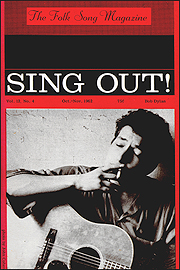 By October of that year, Dylan was on the cover, “Blowing In The Wind” and “Hard Rain’s A Gonna Fall” were in print. Boom, boom and boom again! Songs such as “Little Boxes” by Malvina Reynolds, “Ramblin’ Boy” by Tom Paxton, “Don’t Think Twice” by Bob Dylan and “San Francisco Bay Blues” by Jesse Fuller were in Sing Out! and on everyone’s set list. New songs were being written by a host of great writers, and the magazine couldn’t print these great songs fast enough. But, where did the commercial line end, and where did folk music begin? Some times it was not easy to tell.
By October of that year, Dylan was on the cover, “Blowing In The Wind” and “Hard Rain’s A Gonna Fall” were in print. Boom, boom and boom again! Songs such as “Little Boxes” by Malvina Reynolds, “Ramblin’ Boy” by Tom Paxton, “Don’t Think Twice” by Bob Dylan and “San Francisco Bay Blues” by Jesse Fuller were in Sing Out! and on everyone’s set list. New songs were being written by a host of great writers, and the magazine couldn’t print these great songs fast enough. But, where did the commercial line end, and where did folk music begin? Some times it was not easy to tell.
Silber reports that at the height of the folk revival, Bob Dylan was asked about commercial sponsorship of folk song programs. (The first televised airing of Hootenanny, hosted by that noted folk impresario Jack Linkletter came in April 1963.) “We’re not singing folk-songs in order to sell soap,” Dylan quipped, “Hell, we don’t even buy soap!” By the mid-1960s, folk as a commodity was making a lot of people very, very rich, and some others, very, very nervous. In a show of solidarity, The Kingston Trio, Joan Baez and Peter, Paul & Mary refused to appear on Hootenanny because of the show’s blacklisting of performers such as Pete Seeger and The Weavers.
By the mid-’60s, another form of protest song was being sung by Mr. Dylan, this one aimed squarely at the heart of the folk music movement. Bob Dylan plugged in his electric guitar at the 1965 Newport Folk Festival, and by the time he and the Butterfield Blues Band finished their rocked up version of “Maggie’s Farm,” finished too was the folk boom.
Despite Sing Out!’s grass-roots ties, the fickle attentions of the pop world affected the magazine as well. Declining circulation led to changes on the editorial staff, and longtime editor Irwin Silber sold Sing Out! to a cooperative in 1968. The editorial reigns were taken over by Happy Traum. Traum saw great potential in the magazine as a readers’ guide for creating personal music. He observed:
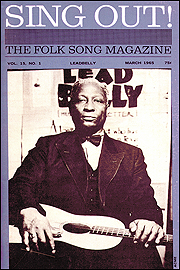 “Sing Out! is the closest thing I’ve ever seen to a truly grassroots, reader-supported magazine, due mostly, I think, to its philosophy of encouraging people to make their own music in a time of alienation and musical overkill in the big money, popular music market.”
“Sing Out! is the closest thing I’ve ever seen to a truly grassroots, reader-supported magazine, due mostly, I think, to its philosophy of encouraging people to make their own music in a time of alienation and musical overkill in the big money, popular music market.”
The old “Git Box” instruction columns of the ’50s were reprised in the late ’60s as “Teach-Ins.” This time, readers were not only learning a myriad of guitar, banjo and fiddle styles, they also received instruction on diverse instruments such as the hurdy-gurdy, hammered dulcimer, Gambian kora, Cajun accordion, harmonica, mouth bow, spoons and pennywhistle. There were even Teach-Ins for street games, shape-note singing, Chassidic tunes and writing children’s songs. Traum says the “Teach-In” proved to be one of the most popular and enduring features of Sing Out!, and the magazine’s impact rose beyond its humble circulation: “[Sing Out!’s] influence extends to a generation of performers who helped shape the world of popular music, especially those who sing and play guitar in anything like a folk style, from Woody Guthrie to Jack Elliott to Bob Dylan to Ry Cooder. It has helped bring the traditional styles of Doc Watson, Big Bill Broonzy, Elizabeth Cotten, Lead Belly, Robert Johnson and John Hurt to innumerable guitarists who play in all styles today, from acoustic folk to electric rock.”
Traum recalls that the magazine also provided a forum for singer-songwriters who altered the sound and writing styles of music in the ’60s and ’70s by injecting meaningful lyrics into popular song. Bob Dylan, Eric Andersen, Tom Paxton, Phil Ochs, Peter LaFarge and Joni Mitchell are only a few whose songs were printed in Sing Out!’s pages. As editor, Traum saw Sing Out! as a player in the popular music scene. Reviews and articles on seminal groups such as the Byrds and Beatles were included along with more traditional fare. Input from music editor and Eastern European folk scholar Ethel Raim also helped renew the magazine’s commitment to sharing music from around the world.
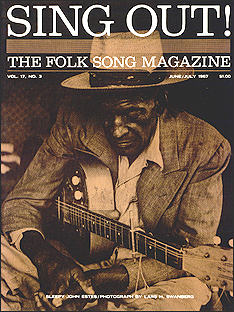 The magazine was making an impact, but a dark shadow was cast over the project. The debt the magazine incurred when it changed hands was carried into the mid-’70s. Bob Norman was at the helm by the end of 1970 and in addition to running the magazine, sought ways to deal with the debt, then somewhat over $15,000. Longtime supporter Josh Dunson organized Friends of Sing Out! Cells of the group sprang up, putting on concerts and sending proceeds to keep the magazine going.
The magazine was making an impact, but a dark shadow was cast over the project. The debt the magazine incurred when it changed hands was carried into the mid-’70s. Bob Norman was at the helm by the end of 1970 and in addition to running the magazine, sought ways to deal with the debt, then somewhat over $15,000. Longtime supporter Josh Dunson organized Friends of Sing Out! Cells of the group sprang up, putting on concerts and sending proceeds to keep the magazine going.
In late 1971, the magazine had embarked on a most ambitious undertaking. It began offering a flexidisc with every other issue of the magazine – a thin plastic record also called a soundsheet. The premise was that this sound recording could let the readers hear some of the music that was written down within the magazine. The innovative feature was extremely popular with the readership, and the subscriber base increased in this era to an all time high ... but the flexi-discs were expensive. By 1973, the debt from the ownership transfer was paid off, but even with circulation increases, the cost of providing the flexi-discs in the magazine was not being covered and the familiar specter of debt again loomed.
In addition, a new, ironic problem appeared during the ’70s: politics. The very activism that launched the magazine caused editorial soul searching and threatened to scuttle the ship when more “purist” folk music fans complained about the growing political nature of the magazine. While most readers were sympathetic with the anti-Vietnam War stance the magazine took, a number of readers believed the magazine was being overtaken by a relentless and strident anti-war tone. They argued that folk music was being given less attention than activism. The war that caused division and turmoil in society put Sing Out! at odds with some of its readership as well.
To be fair, Sing Out! was still many other things: still columns by Michael Cooney and Pete Seeger; still Teach-Ins; still songs; still articles about the best performers on the folk scene, such as Ry Cooder, Bonnie Raitt, Steve Goodman, Paul Siebel and Happy and Artie Traum; and still full of surprises and regular features. In a period of agitation, editor Norman did well to keep the balance between folk music and folk activism. He saw the emphasis at Sing Out! to be on “music as communication,” remarking: “We encourage people to make music. That’s the whole point of our name. We’re still political, but we think anybody can relate to Sing Out!, no matter what their personal politics.”
The war ended, and there were new battles to fight. Norman left by 1977. Both political activism and a sea of red ink defined the era following his departure. This time was also characterized by a rapid turnover of the editorial staff which had included Abby Newton, Rhonda Mattern, Alan Senauke, Estelle Schneider, Francine Brown and soon saw Sara Plant, Mimi Bluestone, Peter Worts-man, Carolyn Bevis, Bob Lusk and others in the office.
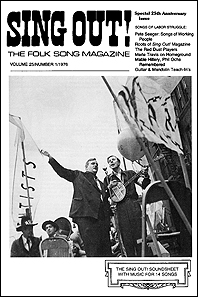 Resources were so low that the salary for paid staffers was a pittance. The debt was essentially being carried by the workers, who accepted little pay for their services, and the printer, who was being paid three jobs late in order to print the current issue. Many other creditors waited patiently, and not so patiently, for payment.
Resources were so low that the salary for paid staffers was a pittance. The debt was essentially being carried by the workers, who accepted little pay for their services, and the printer, who was being paid three jobs late in order to print the current issue. Many other creditors waited patiently, and not so patiently, for payment.
By the time the sixth generation of post-Norman staff members left, things were shaky. Then, when the group decided to do a special issue on “The Year Of The Disabled,” the house of cards came down.
Guest editor Jean Stewart was given the task of getting out the special issue. It was started early in 1981, but money wasn’t there and logistical problems loomed. That issue finally came out a year later ... unfortunately, when “The Year Of The Disabled” had all but passed. Six months later, and no new Sing Out! By June of 1982, it was decided that no further subscriptions could be taken. The rent and staff payments were months behind. This was the darkest period since People’s Songs had folded. If not addressed, the fate of People’s Songs would be revisited and the singing would cease.
Once again it was Pete Seeger and the spirit of People’s Songs to the rescue, this time with the help of a young advisory board member from Easton, Pennsylvania, current editor and executive director Mark D. Moss. They took quick and decisive action to save Sing Out! Pete felt that Sing Out! was too important to let die. He believed that even if Sing Out! had to be mimeographed in someone’s basement, it had to keep going. A reorganization meeting was held after that year’s Hudson River Revival to discuss options.
After a debt of $20,000 was estimated, there was a strong voice from many staffers to close up shop. They pointed to the fact that the subscriber list had fallen to 2,000. Perhaps they had forgotten the power of song ... and that Seeger doesn’t give up easily.
Not remarkably, it was a song that came to Sing Out!’s aid, just as Sing Out!’s songs had rallied other rescue efforts. A song? No, not just any song, but the very same “Hammer Song” which graced the cover of the first issue of Sing Out! to revive the dream of People’s Songs.
Pete allowed his manager Harold Leventhal to license the use of “The Hammer Song” to an English tea company for radio commercials, for which the company would pay $2,000. Pete offered to use that money to publish a monthly newsletter and the first issue of The Sing Out Bulletin was out by August. It let the readership know what was going on behind the scenes, carrying this sad message:
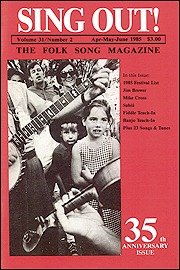 “A fine issue of Sing Out! magazine has been prepared, but there is not money to typeset, print, and mail it. Rather than undertake emergency fund raising, Sing Out! has temporarily suspended publication. It has not gone bankrupt. Subscribers will receive issues due them eventually. Creditors will be paid.”
“A fine issue of Sing Out! magazine has been prepared, but there is not money to typeset, print, and mail it. Rather than undertake emergency fund raising, Sing Out! has temporarily suspended publication. It has not gone bankrupt. Subscribers will receive issues due them eventually. Creditors will be paid.”
The newsletter sought to involve all subscribers in the dialogue of solving the crisis. It asked them to help cast the mold that would form the template for future Sing Out!s. Readers were encouraged to describe the magazine they wanted Sing Out! to become and the readers responded!
Box by box, the magazine was moved out of its high-rent mid-Manhattan office on Eighth Avenue and relocated to Moss’ hometown of Easton. Pete picked up his banjo and headed many fundraising concerts, just like the hootenannies of old. Friends from the People’s Songs days, notable founders such as Carl Reiner and Lena Horne, and also more recent friends like Bob Dylan and Joan Baez, donated to the resurrection. When the dust cleared, more than $30,000 had been raised, Seeger and Moss were co-editors, $22,000 was paid off with $8,000 available for seed money. The spring was set for the startup of the renewed Sing Out!. On the seventh day, Pete Seeger rested.
While setting up a not-for-profit corporation in March of 1983, Moss discovered there were back taxes due, another $9,000 added to the debt. So much for seed money. Still, in April of 1983, the first new-era issue was ready. Once again, it was Phoenix rising from the ashes. This time, Moss remembers; the old bird was sporting some new feathers. The concept of the not-for-profit corporation came with a new twist.
“It was decided to form a national board of directors comprised of people within the community of folk music to help guide the magazine. We also sought to realign and refocus ourselves – clearly stating that folk music was the magazine’s mission and purpose. Doing so acknowledged the magazine’s political roots, but centered the focus of the magazine on what we could do best ... share music!”
Moss became a full-time paid editor when his unemployment checks from a former construction job stopped coming. Staff was added as needed. From this point forward, it was ever onward and steadily upward. The editorial policy held fast that folk music be the raison d’etre of Sing Out! This philosophy was fiercely defended from the back room editorial board meetings, right out into print in Mark’s editorials.
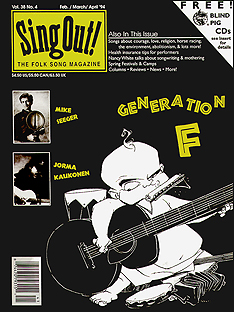 At the same time, in his own examination of the history of Sing Out!, Moss found that the symbiotic relationship the magazine had with Oak Publications during Sing Out!’s heyday was an important reason for its success. This was one of the things that worked about Sing Out! It was decided to relaunch a publishing arm in 1984 when Peter Blood came to Sing Out! with the prototype of what two years later would become Rise Up Singing. “Sing Out! Publications” was born.
At the same time, in his own examination of the history of Sing Out!, Moss found that the symbiotic relationship the magazine had with Oak Publications during Sing Out!’s heyday was an important reason for its success. This was one of the things that worked about Sing Out! It was decided to relaunch a publishing arm in 1984 when Peter Blood came to Sing Out! with the prototype of what two years later would become Rise Up Singing. “Sing Out! Publications” was born.
It was also during this period that the concept of the Sing Out! Resource Center came into being. It would use all manner of information (sound recordings, books, periodicals, photos, video and ephemera) to document the diverse nature and history of folk music. The Resource Center stands today to serve the folk community and is being made even more accessible with the advent of computers. This repository of knowledge helps to serve Sing Out!’s educational mission. It is a reminder that the magazine is grounded in the role of keeping the tradition of folk music alive and accessible to the public. Putting out a magazine and housing a resource center takes space. As the magazine grew, it required a move to larger digs, and this brought it to Bethlehem, Pennsylvania, first in a rented location at 125 East Third Street, then to help ensure the future of our efforts to a three-story building purchased and renovated at 512 East Fourth Street which today houses our growing Resource Center and increasingly sophisticated magazine and publication operations. Computers and software aplenty have changed the process of putting together a magazine. It is a far cry from the look and sound of the old People’s Artists office, yet the dedication is still there. Computers merely make the operation more efficient and ready for the next century where, we hope, there will still be plenty of good songs to sing, singers willing to sing them and Sing Out! to bring singers and songs together.
In the decade following incorporation, the magazine evolved steadily into a professionally respectable journal with a most impressive look and content, and it is today still maturing. Some of the changes were subtle, some more noticeable; magazine format size and layout, type styles and size, color cover graphics, style and story selection.
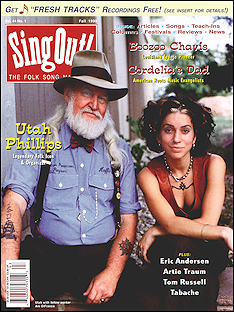 New columns have popped up like “Courting the Muse,” “Hey Rube!” “The British-North America Act,” “Kidsbeat,” “Homemade Jam,” “The Endless Tale,” “RagTag” and even “The SORCe Report,” a column for those interested in the resource center. There are still familiar companions such as “What’s Happening,” Teach-Ins, “The Songfinder,” reviews, festival listings and usually more than 20 songs. All this helps to make Sing Out!s quarterly arrival a special occasion.
New columns have popped up like “Courting the Muse,” “Hey Rube!” “The British-North America Act,” “Kidsbeat,” “Homemade Jam,” “The Endless Tale,” “RagTag” and even “The SORCe Report,” a column for those interested in the resource center. There are still familiar companions such as “What’s Happening,” Teach-Ins, “The Songfinder,” reviews, festival listings and usually more than 20 songs. All this helps to make Sing Out!s quarterly arrival a special occasion.
In late 1998, Sing Out! acquired the respected mail-order folk music and lore book seller, Legacy Books, merging it with the Sing Out! Publications imprint to better serve its membership and the field. Anchored by its long-running review newsletter and catalog, Come All Ye, Legacy Books now offers a portal for Sing Out! members to find a vast array of current and out-of print books and song collections.
More than two decades ago, a very perceptive young writer was challenged to define this “little magazine that could” in a column he wrote for the Free Aquarian. He suggested, “The best way to describe Sing Out! is to call it a mail-order folk festival.”
I was right then – and it is ever more true today – Sing Out! alone brings us this close to the folk music we love. After all, Sing Out! has had 50 years experience in publishing the best songs and the best in folk for singers and listeners like you and me. Now that’s something to sing out about!
“As long as traditional styles of folk music are preserved
and new styles created, Sing Out! will be there,
earning its exclamation point.”
— Utne Reader
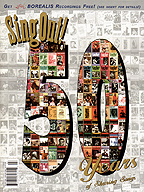
© 1995, 2000 THE SING OUT! CORPORATION